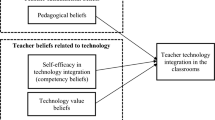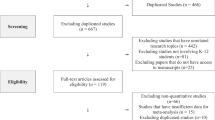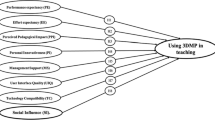Abstract
3D printing technology is a powerful educational tool that can promote integrative STEM education by connecting engineering, technology, and applications of science concepts. Yet, research on the integration of 3D printing technology in formal educational contexts is extremely limited. This study engaged preservice elementary teachers (N = 42) in a 3D Printing Science Project that modeled a science experiment in the elementary classroom on why things float or sink using 3D printed boats. The goal was to explore how collaborative 3D printing inquiry-based learning experiences affected preservice teachers’ science teaching self-efficacy beliefs, anxiety toward teaching science, interest in science, perceived competence in K-3 technology and engineering science standards, and science content knowledge. The 3D printing project intervention significantly decreased participants’ science teaching anxiety and improved their science teaching efficacy, science interest, and perceived competence in K-3 technological and engineering design science standards. Moreover, an analysis of students’ project reflections and boat designs provided an insight into their collaborative 3D modeling design experiences. The study makes a contribution to the scarce body of knowledge on how teacher preparation programs can utilize 3D printing technology as a means of preparing prospective teachers to implement the recently adopted engineering and technology standards in K-12 science education.







Similar content being viewed by others
References
ACT. (2015). The Condition of STEM 2015. Retrieved from http://www.act.org/content/dam/act/unsecured/documents/National-STEM-Report-2015.pdf
Agency by Design. (2015). Maker-centered learning and the development of self: preliminary findings of the Agency by Design Project. Project Zero: Harvard Graduate School of.
Annetta, L. A., Frazier, W. M., Folta, E., Holmes, S., Lamb, R., & Cheng, M. –. T. (2013). Science teacher efficacy and extrinsic factors toward professional development using video games in a design-based research model: The next generation of STEM learning. Journal of Science Education and Technology, 22(1), 47–61.
Appleton, K. (2006). Science pedagogical content knowledge and elementary school teachers. In K. Appleton (Ed.), Elementary science teacher education: International perspectives on contemporary issues and practice (pp. 31–54). Mahwah, NJ: Lawrence Erlbaum.
Avery, L. M., & Meyer, D. Z. (2012). Teaching science as science is practiced: opportunities and limits for enhancing preservice elementary teachers’ self-efficacy for science and science teaching. School Science and Mathematics, 112(7), 395–409.
Aydin, S., & Boz, Y. (2010). Pre-service elementary science teachers’ science teaching efficacy beliefs and their sources. Elementary Education Online, 9(2), 694–704.
Bandura, A. (1997). Self-efficacy: the exercise of control. New York: Freeman.
Beilock, S. L., & Maloney, E. A. (2015). Math anxiety: a factor in math achievement not to be ignored. Policy Insights from the Behavioral and Brain Sciences, 2(1), 4–12.
Beilock, S. L., Gunderson, E. A., Ramirez, G., & Levine, S. C. (2010). Female teachers’ math anxiety affects girls’ math achievement. Proceedings of the National Academy of Sciences of the United States of America, 107(5), 1860–1863.
Buehler, E., Comrie, N., Hofmann, M., McDonald, S., & Hurst, A. (2016). Investigating the implications of 3D printing in special education. ACM Transactions on Accessible Computing, 8(3), 1–28.
Bursal, M., & Paznokas, L. (2006). Mathematics anxiety and preservice elementary teachers’ confidence to teach mathematics and science. School Science and Mathematics, 106(4), 173–180.
Bybee, R. W., Taylor, J. A., Gardner, A., Van Scotter, P., Powell, J. C., Westbrook, A., & Landes, N. (2006). The BSCS 5E instructional model: origins, effectiveness, and applications. Colorado Springs, CO: Biological Sciences Curriculum Study.
Cantrell, P., Young, S., & Moore, A. (2003). Factors affecting science teaching efficacy of preservice elementary teachers. Journal of Science Teacher Education, 14(3), 177–192.
Casey, B., (2012). STEM Education: Preparing for the Jobs of the Future, A Report by the (U.S. Congress) Joint Economic Committee Chairman’s Staff Senator Bob Casey, April 2012.
Chen, J. A., Tutwiler, M. S., Metcalf, S. J., Kamarainen, A., Grotzer, T., & Dede, C. (2016). A multi-user virtual environment to support students’ self-efficacy and interest in science: a latent growth model analysis. Learning and Instruction, 41, 11–22.
Chien, Y.-H. (2017). Developing a pre-engineering curriculum for 3D printing skills for high school technology education. Eurasia Journal of Mathematics, Science and Technology Education, 13(7), 2941–2958.
Deci, E. L., & Ryan, R. M. (1985). The general causality orientations scale: self-determination in personality. Journal of Research in Personality, 19, 104–134.
Deci, E. L., Eghrari, H., Patrick, B. C., & Leone, D. R. (1994). Facilitating internalization: the self-determination theory perspective. Journal of Personality, 62(1), 119–142.
Diamond, Maerten-Rivera, Rohrer, & Lee. (2014). Effectiveness of a curricular and professional development intervention at improving elementary teachers' science content knowledge and student achievement outcomes: year 1 results. Journal of Research in Science Teaching, 51(5), 635–658.
Eccles, J., & Wang, M. T. (2016). What motivates females and males to pursue careers in mathematics and science? International Journal of Behavioral Development, 40(2), 100–106.
Enochs, L. G., & Riggs, I. M. (1990). Further development of an elementary science teaching efficacy belief instrument: a preservice elementary scale. School Science and Mathematics, 90(8), 694–706. https://doi.org/10.1111/j.1949-8594.1990.tb12048.x.
Eshach, H. (2003). Inquiry-events as a tool for changing science teaching efficacy belief of kindergarten and elementary school teachers. Journal of Science Education and Technology, 12(4), 495–501.
Fennema, E., & Sherman, J. A. (1976). Fennema-Sherman mathematics attitudes scales: instruments designed to measure attitudes toward the learning of mathematics by females and males. Journal for Research in Mathematics Education, 7(5), 324–326.
Gess-Newsome, J. (2001). The use and impact of explicit instruction about the nature of science and science inquiry in an elementary science methods course. Science & Education, 11, 55–67.
Glaser, B. G., & Strauss, A. L. (1967). The discovery of grounded theory: strategies for qualitative research. New York: Aldine de Gruyter.
Grant, C. A., MacFadden, B. J., Antonenko, P., & Perez, V. J. (2017). 3-D fossils for k–12 education: a case example using the giant extinct shark Carcharocles Megalodon. The Paleontological Society Papers, 22, 197–209.
Grigg, W., Lauko, M., & Brockway, D. (2006). The Nationís Report Card: Science 2005 (NCES 2006-466). U.S. Department of Education, National Center for Education Statistics. Washington, D.C.: U.S. Government Printing Office.
Gross, B. C., Erkal, J. L., Lockwood, S. Y., Chen, C., & Spence, D. M. (2014). Evaluation of 3D printing and its potential impact on biotechnology and the chemical sciences. Analytical Chemistry, 86(7), 3240–3253.
Gunning, A. M., & Mensah, F. M. (2011). Preservice elementary teachers’ development of self-efficacy and confidence to teach science: a case study. Journal of Science Teacher Education, 22(2), 171–185.
Hadley, K. M., & Dorward, J. (2011). The relationship among elementary teachers’ mathematics anxiety, mathematics instructional practices, and student mathematics achievement. Journal of Curriculum and Instruction, 5(2), 27–44.
Hodgin, C.M. (2014). Science teaching anxiety: The impact of beliefs on teacher preferences of instructional strategies (Doctoral dissertation). Retrieved from https://repositories.lib.utexas.edu/handle/2152/24744.
Hopko, D. R. (2003). Confirmatory factor analysis of the math anxiety rating scale—revised. Educational and Psychological Measurement, 63(2), 336–351.
Jaipal-Jamani, K., &, Angeli, C. (2017). Effect of robotics on elementary preservice teachers’ self-efficacy, science learning, and computational thinking. Journal of Science Education and Technology, 26, 175–192, 2.
Jang, S. J. (2008a). The effects of integrating technology, observation and writing into a teacher education method course. Computation and Education, 50(3), 853–965.
Jang, S. J. (2008b). Innovations in science teacher education: effects of integrating technology and team-teaching strategies. Computation and Education, 51(2), 646–659.
Jang, S. J., & Chen, K. C. (2010). From PCK to TPACK: developing a transformative model for pre-service science teachers. Journal of Science Education and Technology, 19(6), 553–564.
Johnson, L., Adams Becker, S., Estrada, V., & Freeman, A. (2015). NMC horizon report: 2015 higher education edition.
Kazempour, M. (2014). I can’t teach science! A case study of an elementary pre-service teacher’s intersection of science experiences, beliefs, attitude, and self-efficacy. International Journal of Environmental & Science Education, 9, 77–96.
Kim, M. C., Hannafin, M. J., & Bryan, L. A. (2007). Technology-enhanced inquiry tools in science education: an emerging pedagogical framework for classroom practice. Science Education, 91(6), 1010–1030.
Kim, C., Kim, D., Yuan, J., Hill, R. B., Doshi, P., & Thai, C. N. (2015). Robotics to promote elementary education pre-service teachers’ STEM engagement, learning, and teaching. Computers & Education, 91(Supplement C), 14–31.
Koka, A., & Hein, V. (2003). Perceptions of teacher’s feedback and learning environment as predictors of intrinsic motivation in physical education. Psychology of Sport and Exercise, 4(4), 333–346.
Kostakis, V., Niaros, V., & Giotitsas, C. (2015). Open source 3D printing as a means of learning: an educational experiment in two high schools in Greece. Telematics and Informatics, 32(1), 118–128.
Leduc-Mills, B., & Eisenberg, M. (2011). The UCube: a child-friendly device for introductory three-dimensional design. In Paper presented at the proceedings of the 10th international conference on interaction design and children. New York: ACM.
Lewis, S. P., Alacaci, C., O’Brien, G. E., & Jiang, Z. (2002). Preservice elementary teachers' use of mathematics in a project-based science approach. School Science and Mathematics, 102(4), 172–180.
Liang, L. L., & Richardson, G. M. (2009). Enhancing prospective teachers’ science teaching efficacy beliefs through scaffolded, student-directed inquiry. Journal of Elementary Science Education, 21(1), 51–66.
Lubinski, D., & Benbow, C. P. (2006). Study of mathematically precocious youth after 35 years: uncovering antecedents for the development of math-science expertise. Perspectives on Psychological Science, 1(4), 316–345.
Maloy, R., Trust, T., Kommers, S., Malinowski, A., & LaRoche, I. (2017). 3D modeling and printing in history/social studies classrooms: initial lessons and insights. Contemporary Issues in Technology and Teacher Education, 17(2).
McMenamin, P. G., Quayle, M. R., McHenry, C. R., & Adams, J. W. (2014). The production of anatomical teaching resources using three-dimensional (3D) printing technology. Anatomical Sciences Education, 7(6), 479–486.
Mellis, D. A., & Buechley, L. (2012). Case studies in the personal fabrication of electronic products. Paper presented at the proceedings of the designing interactive systems conference, ACM, New York.
Mintzes, J. J., Marcum, B., Messerschmidt-Yates, C., & Mark, A. (2013). Enhancing self-efficacy in elementary science teaching with professional learning communities. Journal of Science Teacher Education, 24(7), 1201–1218.
National Academies of Sciences, Engineering, and Medicine (2015). Science teachers’ learning: Enhancing opportunities, creating supportive contexts. Washington, DC: The National Academies Press https://doi.org/10.17226/21836, 2016.
National Research Council (2012). A Framework for K-12 Science Education: Practices, Crosscutting Concepts, and Core Ideas (committee on a conceptual framework for new K-12 science education standards. Board on science education, division of behavioral and social sciences and education ed.). Washington, DC: The National Academies Press.
Ohio Department of Education (2011). Ohio’s New Learning Standards: Science Standards. Retrieved from: http://education.ohio.gov/getattachment/Topics/Ohios-Learning-Standards/Science/ScienceStandards.pdf.aspx
Olson, A. & Rowland, T., Science Buddies Staff. (2014). How Much Weight Can Your Boat Float?. Retrieved August 5, 2016 from http://www.sciencebuddies.org/science-fair-projects/project_ideas/Aero_p020.shtml).
Palmer, D. H. (2006). Sources of self-efficacy in a science methods courses for primary teacher education students. Research in Science Education, 36(4), 337–353.
Papavlasopoulou, S., Giannakos, M. N., & Jaccheri, L. (2017). Empirical studies on the maker movement, a promising approach to learning: a literature review. Entertainment Computing, 18, 57–78.
Peterson, R. A. (1994). A meta-analysis of Cronbach’s coefficient alpha. Journal of Consumer Research, 21(2), 381–391.
Quinn, H., & Bell, P. (2013). How designing, making, and playing relate to the learning goals of K-12 science education. In M. Honey & D. E. Kanter (Eds.), Design. Make. Play: growing the next generation of STEM innovators (pp. 17–33). New York, NY: Routledge.
Resnick, M., & Rosenbaum, E. (2013). Designing for tinkerability. In M. Honey & D. E. Kanter (Eds.), Design. Make. Play. Growing the next generation of STEM innovators (pp. 163–181). New York, NY: Routledge.
Rodenbough, P. P., Vanti, W. B., & Chan, S.-W. (2015). 3-D printing crystallographic unit cells for learning materials science and engineering. Journal of Chemical Education, 92(11), 1960–1962.
Senler, B. (2016). Pre-service science teachers’ self-efficacy: the role of attitude, anxiety and locus of control. Austrailian Council for Educational Research, 60(1), 26–41.
Siegel, M., & Ranney, M. (2003). Developing the changes in attitude about the relevance of science (CARS) questionnaire and assessing two high school science classes. Journal of Research in Science Teaching, 40(8), 757–775.
Smith, R. C., Iversen, O. S., & Hjorth, M. (2015). Design thinking for digital fabrication in education. International Journal of Child-Computer Interaction, 5, 20–28.
Sullivan, P., & McCartney, H. (2017). Integrating 3D printing into an early childhood teacher preparation course: Reflections on practice. Journal of Early Childhood Teacher Education, 38(1), 39–51.
Trust, T., & Kommers, S. (2017). From 2D thinking to 3D printing: preservice and in-service teacher teams explore a new technology. In M. Grassetti & S. Brookby (Eds.), Advancing Next-Generation Teacher Education through Digital Tools and Applications: Information Science Reference.
Vaccarezza, M., & Papa, V. (2015). 3D printing: a valuable resource in human anatomy education. Anatomical Science International, 90(1), 64–65.
van Aalderen-Smeets, S. I., & Walma van der Molen, J. (2015). Improving primary teachers’ attitudes toward science by attitude-focused professional development. Journal of Research in Science Teaching, 52(5), 710–734.
Velthuis, C., Fisser, P., & Pieters, J. (2014). Teacher training and pre-service primary teachers’ self-efficacy for science teaching. Journal of Science Teacher Education, 25(4), 445–464.
Verner, I., & Merksamer, A. (2015). Digital Design and 3D Printing in Technology Teacher Education. Procedia CIRP, 36(Supplement C), 182–186.
Winkelmann, A. (2007). Anatomical dissection as a teaching method in medical school: a review of the evidence. Medical Education, 41(1), 15–22.
Yi, S., Park, H., & Lee, Y. (2016). Development of the TPACK-Based Curriculum with 3D Printer for Pre-service Teachers. Paper presented at the E-Learn: World Conference on E-Learning in Corporate, Government, Healthcare, and Higher Education 2016, Washington, DC, United States. https://www.learntechlib.org/p/173978
Yin, Y. (2005). The influence of formative assessments on student motivation, achievement, and conceptual change. (PhD dissertation), Stanford University.
Yin, Y., Tomita, M. K., & Shavelson, R. J. (2008). Diagnosing and dealing with student misconceptions: Floating and sinking. Science Scope, 8, 34–39.
Yürük, N. (2011). The predictors of pre-service teachers’ anxiety about teaching science. Journal of Baltic Science Education, 10(1), 17–26.
Author information
Authors and Affiliations
Corresponding author
Ethics declarations
Ethical Approval
All procedures performed in studies involving human participants were in accordance with the ethical standards of the institutional and/or national research committee and with the 1964 Helsinki declaration and its later amendments or comparable ethical standards.
Informed Consent
Informed consent was obtained from all individual participants included in the study.
Conflict of Interest
The authors declare that they have no conflict of interest.
Appendix. 3D printing science project description
Appendix. 3D printing science project description
How Much Cargo Can Your Boat Carry? (adapted from Olson, A. & Rowland, T., Science Buddies Staff. (2014, October 22). How Much Weight Can Your Boat Float?. Retrieved August 5, 2016 from http://www.sciencebuddies.org/science-fair-projects/project_ideas/Aero_p020.shtml)





Rights and permissions
About this article
Cite this article
Novak, E., Wisdom, S. Effects of 3D Printing Project-based Learning on Preservice Elementary Teachers’ Science Attitudes, Science Content Knowledge, and Anxiety About Teaching Science. J Sci Educ Technol 27, 412–432 (2018). https://doi.org/10.1007/s10956-018-9733-5
Published:
Issue Date:
DOI: https://doi.org/10.1007/s10956-018-9733-5




